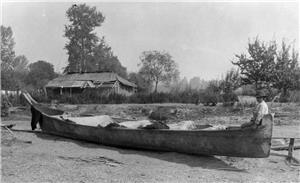For thousands of years, people who lived on Lake Washington have used its waters in their daily lives. In the last 150 years, the methods of crossing the lake to transport goods and people from one side to another have changed greatly. (This essay was written for students in third and fourth grade who are studying Washington State History and for all beginning readers who want to learn more about Washington. It is one of a set of essays called HistoryLink Elementary, all based on existing HistoryLink essays.)
From Canoes to Ferries to Bridges
The Native Americans who lived in this area traveled in canoes carved from cedar logs. They used their canoes to fish, hunt, visit friends and family, and trade with other tribes. When they first arrived, new settlers found it very helpful that the Native people had canoes and were willing to help them move their families and belongings to hard-to-reach home sites. Indians also helped the settlers get access to markets and resources. But the settlers soon found they need larger boats. So they built flat-bottomed boats called scows to move their belongings, transport their produce, and travel around the lake.
The early scows did not have engines, so crossing the lake in them was uncomfortable and slow. Steamboats were designed to carry more people and freight in a safer and quicker manner. Soon the lake was crowded with steamers moving back and forth between neighborhood landings and docks. These ships were part of what was called the Mosquito Fleet because they looked like a swarm of insects skimming across the water. Slow-moving ferries that carried passengers as well as their vehicles later also helped to improve transportation across the lake.
As more people began to use cars and trucks, the need for bridges across the lake grew. Bridges would allow people to travel from one side of the lake to the other to reach their homes or businesses much more quickly than taking a ferry -- or driving around the lake. Bridges allowed industries on the east side of Lake Washington to move products to the seaport in Seattle more economically. Many new homes were built in towns like Bellevue and Kirkland.

